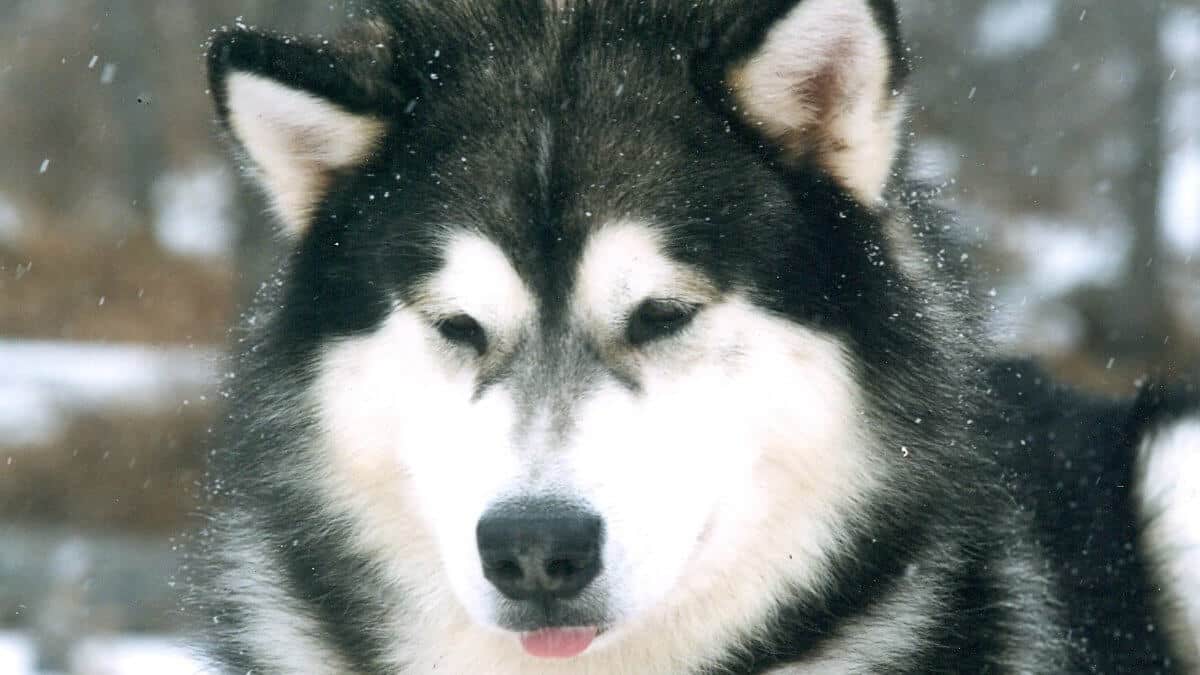


Home » The Alaskan Malamute

This article was originally published in Showsight Magazine, February 2017 issue.
Known as the largest of the sled dogs in the Arctic, the Alaskan Malamute has recently been named as the “State Dog of Alaska”. The breed was originally recognized as indigenous to the northwest coastal area of Alaska, that which was inhabited by the ‘Mahlemuit’ Indian tribes. These tribes used Malamutes as sled and hunting dogs.
Descriptions and purported samples of the ‘Mahlemoots’ served as models for various breeders in the Lower 49 whose work lead to the eventual recognition of the breed with the American Kennel Club in 1935. However, most Malamute fanciers today don’t know that it has not in fact been demonstrated that any genes from those Northern Alaskan dogs actually contributed to the Alaskan Malamute as we know them today. Those progenitors came from points as far apart as the Yukon and Baffin Island, and not until the AKC reopened the stud book for Malamutes in 1950 following the loss of many existing dogs on the Admiral Byrd Antarctic expeditions, did any dogs actually come from Alaska to the lower states. These were a distinctly different type (larger, less compact) compared to the earlier Malamutes. While the dogs extracted from dogs used in the freighting teams during the Alaska and Yukon gold rushes resembled fanciers’ visions of what this breed should be, again, none actually came from Northwestern Alaska. As the ‘Malamutes’ of the day were generally seen as more desirable in temperament and durability than the usual run-of-the-mill dogs of the North, it was common for those trading in dogs to call their sled dogs that name, whether or not they actually were.
In any event, the breed was accepted in America as a distinct type, as compared to the ‘Eskimo Dogs’ previously recognized by AKC, and in due course, also by the Canadian Kennel Club. The first Alaskan Malamute Champion of Record with the CKC was actually a white male owned by Lorna Jackson of Ontario.
The head is NOT the most important aspect of this breed!
We all know that the Alaskan Malamute is a sled dog for heavy freighting. The part that is often overlooked or minimized is the addendum—“in the Arctic”. Essentially, all breeds of dogs were developed by intention or by happenstance for specific purposes and functions; for hunting, draft, coursing, hunting varmints, companionship or for sport. But perhaps no other breed was as essential to its human counterparts for their very survival. Whether utilized by the semi-nomadic Inuit to move to new hunting grounds, or tracking seal and bear game, or for hauling the fruits of a successful hunt back to their villages by sensing the return route in the featureless Arctic, these dogs made possible survival in the most horrendous conditions imaginable.
Even more impressive than their ability to transport large loads, is their ability to survive extreme cold with minimal food. A compact structure with an incredibly dense coat and an extremely efficient digestive system was essential. As these dogs had no knowledge of kennels and chains, and were left to roam loose between excursions, it was inevitable that these sled dogs would develop the skill to augment their own meager diets by hunting on their own. Indeed, modern Malamutes are still quite predatory in nature if not socialized away from that at an early age.
While today most Malamutes live in conditions that are much less harsh than those their ancestors had to endure not so long ago, it is important that breeders aim their efforts at ensuring that those dogs that will not embark on Arctic expeditions remain capable, nevertheless, of doing exactly that on the basis of their structure, toughness, temperament and health. The Malamute is not a ‘one man dog’ but is willing to be friends with anyone given the opportunity. They should not be standoffish or aggressive with humans at any time, though, they can be quite territorial around other dogs. Given the realities of urban and suburban life, temperaments of many Malamutes today are much softer than even a few generations ago.
Health issues exist, although for a large breed, these are perhaps fewer than many breeds. As with humans, cancer is likely the number one cause of shortened lives in Malamutes. Kidney failures, hip dysplasia, autoimmune issues, epilepsy and cataracts may occur as well.
Bigger is NOT better. There is a natural range in size within the breed. the desirable freighting sizes are males, 25″ at the shoulders and 85 lbs.; females, 23″ and 75 lbs.
It was once common to hear a judge in the Alaskan Malamute ring, having put up a particularly impressive specimen declare, “This dog could pull me out of a snow drift any time.”
It goes without saying that a large dog will exert more pulling power force than a smaller dog in equal condition, in equal conditions. However, a Malamute is not designed for short bursts of pulling power; the auto club should be contacted if you need to get out of a snow bank. The Alaskan Malamute is designed to pull heavy loads over long distances—which is to say, sustained effort. While the words of the breed standard make it clear that one should not exclude a large dog of considerable merit, it makes it absolutely clear that a smaller dog of equal merit also should not be overlooked. “When dogs are judged equal in type, proportion, movement and other functional attributes, the dog nearest the desirable freighting size is to be preferred.”
That is to repeat, NEAREST the desirable freighting size, NOT the larger one. And especially the larger dog should not go up purely on size regardless of soundness. The larger dog may win on pure power for the short duration, but one should never forget, these dogs need to continue their effort over many hours and many miles and do it on minimal food ingested. A very large dog would expend more energy just hauling himself down the trail, while also requiring a much larger food supply than a smaller dog. The original standard for the breed recognized by the AKC in 1935 called for males at 22 to 25 inches, females at 20 to 23 inches, today it seems that even dogs at the larger end of that range are considered too small; not too small to be successful freighting dogs, but too small to win in the ring. Priorities have been misplaced!
The words of the standard are as clear as the English language can make it in the summary: “The legs of the Malamute must indicate unusual strength and tremendous pulling power. Any indication of unsoundness in legs or feet, standing or moving is considered a serious fault. Faults under this provision include; splay-footedness cow hocks, bad pasterns, straight shoulders, lack of angulation, stilted gait (or any gait that isn’t balanced, strong and steady) ranginess, ponderousness, lightness of bone and poor overall proportions.”
To reiterate in the words of the authors of The Alaskan Malamute, Yesterday and Today, “The Malamute in its correct form is a marvel of efficiency, while he is well muscled and more heavily boned than his other Northern cousins, he is never an overblown cartoon, nor is he a slow clumsy plodder.” Soundness of limb and movement are vital to the Malamute’s function. When interpreting the standard as much emphasis must be given to the attributes of soundness as to those describing substantial build. Throughout the standard, the three words used most often to describe the Alaskan Malamute are strong, powerful and sound.
All aspects of an Alaskan Malamute contribute to the identity of the breed and its ability to do its tasks. However, some are more critical than others.
Feet: After balanced angulation (front to rear to be the same), no conformation trait is as important to Malamutes at work than their feet. Poor feet (ones that are not large, compact toes well arched, pads thick) on a Malamute are like wheelbarrow tires on a work truck. These have sometimes been called “snowshoe feet,” which is in a fact a misnomer as it gives the impression that large feet are intended to help the dog stay atop the snow; in fact they are intended to give maximum traction in slippery conditions and maximum shock absorption when on the move
Bend of Stifle: Moderate. This is a heavy-trotting dog, not a Sight Hound.
Coat & Color: Malamutes are double coated, with a coarsely textured outer layer over a short dense undercoat. Colors range from silver grey through darker shades to black and red. Sable shadings are acceptable. White is the only solid color allowed. No color is preferred. Trimming is allowed only to tidy feet. Cutting the hair on the underside of a dog to give appearance of more leg length is not permitted.
Topline: It is SLIGHTLY sloping. Extreme slope indicates straight shoulders and/or overdone rear.
Finally, because of the varied sources of the original ‘Malamutes’, it was common to see considerable visual variation in the breed. And indeed, these differences continued for some years as fanciers’ with the various iterations tended to remain loyal to them, therefore resisting going outside. However, eventually the walls came down and today the lines and styles have been increasingly mixed and variations are now less extreme. However, those older genes have not completely disappeared and dogs demonstrating traits from the past still pop up from time to time. As they are still, indeed, Alaskan Malamutes, these should not be discriminated against on style, only on type, soundness and their ability to continue as sled dogs for heavy freighting.